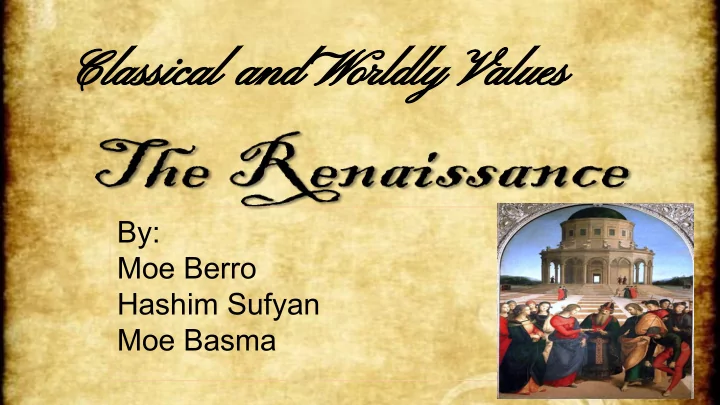

Classical and Worldly Values By: Moe Berro Hashim Sufyan Moe Basma
Bellwork 19 January 2016 How did Looking to Greece and Rome encourage the Renaissance in Italy? Explain. (pg.472) ● The artists and scholars of Italy drew inspiration from the ruins of Rome that surrounded them. ● Western scholars studied ancient latin manuscripts that had been preserved in monasteries. ● Christian scholars in Constantinople fled to Rome with Greek manuscripts when the Turks conquered constantinople in 1453.
Classics lead to Humanism ● Humanists influenced artists ● The study of classical texts and architects to carry on led to humanism, an classical traditions. intellectual movement that ● Instead of trying to make focused on human potential classical texts agree with and achievements. Christian teachings as ● Humanists popularized the medieval scholars had, study of subjects common to humanists studied them to classical education, such as understand ancient Greek History, literature and values. philosophy.
Worldly Pleasures ● In the middle ages some ● Humanists suggested that a people demonstrated their person might enjoy life piety by wearing rough without offending god. clothing and eating plain ● In Renaissance Italy, the foods. wealthy enjoyed material ● Most people remained luxuries, good music, and fine devout Catholics. However, foods. the basic spirit of the Renaissance society was secular.
What is Humanism? An intellectual movement that focused on human potential and achievements. How was the basic spirit of the Renaissance secular? Most people were concerned about worldly matters rather than spiritual. Even church leaders were more concerned with material values.
Patrons Of The Arts ● Church leaders during the Renaissance beautified Rome and other cities by spending huge amounts of money for art. ● They became Patrons of the arts by financially supporting artists. ● Renaissance merchants and wealthy families also were the patrons of arts. ● By having their portraits painted or by donating art to the city to place in public squares,the wealthy demonstrated their own importance.
The Renaissance Man ● Baldassare Castiglione wrote ● Renaissance writers a book called the “Courtier’’ in introduced the idea that all 1528,the book taught how to educated people were become such a great person. expected to create art. ● A young man should be ● A man who excelled in many charming,witty,and well fields was referred to as a educated in the classics. In “universal man’’. addition,he should be a skilled ● The ideal individual strove to rider,wrestler,and swordsman. master almost every study area possible.
How did Church leaders and wealthy merchants support the Arts? They had their portraits painted and they donated Art to the city to place in public squares. How were the expectations for Renaissance men and Renaissance women similar? Both Renaissance men and women were to inspire art. Both should study the classics and be charming.
The Renaissance Woman ● Upper class woman also ● A few women such as should be known as the Isabella d’Este did exercise classics and be charming. power. ● They were not expected to ● Isabella was skilled in politics seek fame, they were and she was born into the expected to inspire art but ruling family of the city state rarely to create it. of Ferrara. ● Most Renaissance Woman ● Upper class women were had little influence on politics. more educated than medieval woman.
Background Knowledge Isabella d’Este Baldassare Castiglione
Baldassare Castiglione ● Castiglione was born in Casatico,near Mantua on December 6, 1478. ● Castiglione was educated at the humanist schools of Gregorio Merual. ● In 1516, he married a Bolognese Noblewoman, Ippolita Torelli, who died in 1520 in childbirth. ● Castiglione died of plague fevers in Toledo on February 8,1529. ● After his death in 1529 a monument was erected to him in the sanctuary of Sta Maria delle Grazie, outside of his birthplace of Mantua
Isabella d’Este ● Isabella d’Este was born on May 18, 1474 in Ferrara, Italy. ● At age 16 she got married to Francesco il Gonzaga. ● Isabella is a notable patron of the arts and collector of antiquities. ● She established the first known studiolo created for a woman. ● Isabella and Francesco had 7 Children.
● A connection between the Renaissance and the Reformation is that together they have ended the Middle Ages. The Middle Ages were a time in which people relied on the Church as their only source of authority. They believed what the Church told them about everything from the meaning of the Bible to the way the universe was created.The Renaissance, for example, brought an emphasis on science and on scientific proof instead of relying on what religious authorities said. The Reformation, of course, weakened the idea that the Church was the only source of religious knowledge. ● ● A connection between the Renaissance and ancient Greece is that the Renaissance was a rebirth of art, architecture, and music of Ancient Greece. People in both The Renaissance and Ancient Greece studied the classics.
Recommend
More recommend